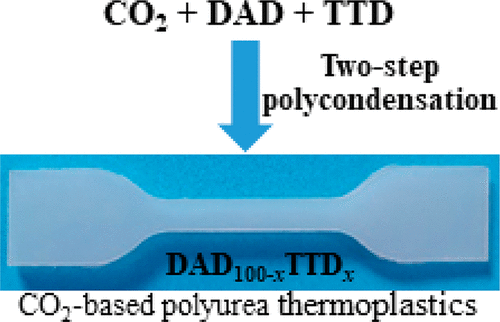当前位置:
X-MOL 学术
›
ACS Appl. Mater. Interfaces
›
论文详情
Our official English website, www.x-mol.net, welcomes your
feedback! (Note: you will need to create a separate account there.)
Direct Synthesis of Polyurea Thermoplastics from CO2 and Diamines.
ACS Applied Materials & Interfaces ( IF 8.3 ) Pub Date : 2019-12-09 , DOI: 10.1021/acsami.9b17677 Shan Jiang 1, 2 , Hai-Yang Cheng 1, 2 , Ru-Hui Shi 1, 2 , Pei-Xuan Wu 1, 2 , Wei-Wei Lin 1, 2 , Chao Zhang 1, 2 , Masahiko Arai 1, 2 , Feng-Yu Zhao 1, 2
ACS Applied Materials & Interfaces ( IF 8.3 ) Pub Date : 2019-12-09 , DOI: 10.1021/acsami.9b17677 Shan Jiang 1, 2 , Hai-Yang Cheng 1, 2 , Ru-Hui Shi 1, 2 , Pei-Xuan Wu 1, 2 , Wei-Wei Lin 1, 2 , Chao Zhang 1, 2 , Masahiko Arai 1, 2 , Feng-Yu Zhao 1, 2
Affiliation

|
The transformation of CO2 into polymeric materials is an important and hot research topic from the viewpoint of renewable resources and environmental effects. Herein, a series of polyureas have been synthesized by polycondensation from CO2 with diamines of 1,12-diaminododecane (DAD) and/or 4,7,10-trioxa-1,13-tridecanediamine (TTD). The properties of polyureas synthesized were characterized by FTIR, 1H NMR, 13C NMR, XRD, DSC, TGA, and DMA. The polyureas synthesized from CO2 with a mixture of diamines presented high performances compared to those of polyureas synthesized from CO2 with a single diamine. The thermal and mechanical properties were improved largely by the variation in the crystallization and the chain flexibility depending on the changes in the density and/or intensity of hydrogen bonds. With increasing amounts of TTD from 0 to 100% in weight, the melting (Tm), crystallization (Tc), and glass transition (Tg) temperatures decreased from 207 to 116 °C, from 181 to 54 °C, and from 66 to -34 °C, respectively. When the TTD content was increased from 0 to 50 wt %, the Young's modulus decreased from 1170 to 406 MPa, and the tensile strength decreased from 53.3 to 42.9 MPa. However, the elongation at break increased from 13 to 330%. Furthermore, the chain length of aliphatic diamines and polyetheramines had a significant effect on the mechanical properties. The initial decomposition temperature (Td,5%) is >295 °C, about 110 °C higher than the Tm (116-207 °C), which is advantageous for the postprocessing. The mechanical properties of the polyureas synthesized herein are superior to those of polycarbonate and polyamide 6. Thus, polyureas synthesized from the renewable and cheap resources, CO2 and diamines, will find wide potential applications in the field of polymeric materials.
中文翻译:

由CO2和二胺直接合成聚脲热塑性塑料。
从可再生资源和环境影响的角度来看,将二氧化碳转化为聚合物材料是一个重要而热门的研究课题。本文中,已经通过由CO 2与1,12-二氨基十二烷(DAD)和/或4,7,10-三氧杂-1,13-十三烷二胺(TTD)的二胺缩聚来合成一系列聚脲。通过FTIR,1 H NMR,13 C NMR,XRD,DSC,TGA和DMA表征合成的聚脲的性质。与由CO 2与单二胺合成的聚脲相比,由CO 2与二胺的混合物合成的聚脲表现出较高的性能。取决于氢键的密度和/或强度的变化,结晶度和链柔性的变化极大地改善了热和机械性能。随着TTD含量从0%增至100%,熔融(Tm),结晶(Tc)和玻璃化转变(Tg)温度从207降至116°C,从181降低至54°C,从66降低至60。分别为-34°C。当TTD含量从0增加到50wt%时,杨氏模量从1170降低到406MPa,抗拉强度从53.3降低到42.9MPa。但是,断裂伸长率从13%增加到330%。此外,脂族二胺和聚醚胺的链长对机械性能有重要影响。初始分解温度(Td,5%)> 295°C,比Tm(116-207°C)高约110°C,这对于后处理是有利的。本文合成的聚脲的机械性能优于聚碳酸酯和聚酰胺6的机械性能。因此,
更新日期:2019-12-11
中文翻译:

由CO2和二胺直接合成聚脲热塑性塑料。
从可再生资源和环境影响的角度来看,将二氧化碳转化为聚合物材料是一个重要而热门的研究课题。本文中,已经通过由CO 2与1,12-二氨基十二烷(DAD)和/或4,7,10-三氧杂-1,13-十三烷二胺(TTD)的二胺缩聚来合成一系列聚脲。通过FTIR,1 H NMR,13 C NMR,XRD,DSC,TGA和DMA表征合成的聚脲的性质。与由CO 2与单二胺合成的聚脲相比,由CO 2与二胺的混合物合成的聚脲表现出较高的性能。取决于氢键的密度和/或强度的变化,结晶度和链柔性的变化极大地改善了热和机械性能。随着TTD含量从0%增至100%,熔融(Tm),结晶(Tc)和玻璃化转变(Tg)温度从207降至116°C,从181降低至54°C,从66降低至60。分别为-34°C。当TTD含量从0增加到50wt%时,杨氏模量从1170降低到406MPa,抗拉强度从53.3降低到42.9MPa。但是,断裂伸长率从13%增加到330%。此外,脂族二胺和聚醚胺的链长对机械性能有重要影响。初始分解温度(Td,5%)> 295°C,比Tm(116-207°C)高约110°C,这对于后处理是有利的。本文合成的聚脲的机械性能优于聚碳酸酯和聚酰胺6的机械性能。因此,





















































 京公网安备 11010802027423号
京公网安备 11010802027423号